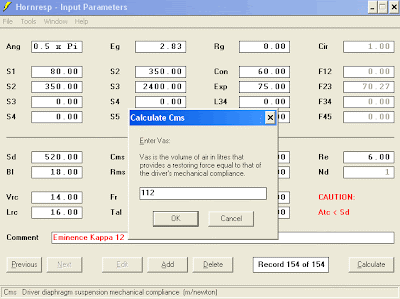Tuesday, November 20, 2007
Monday, November 19, 2007
The Dino Horn
This is a vintage design. It was featured in the Klinger loudspeaker book, and that's about all I know about its origins.
This picture comes from the World Tune website, an art project that travels around, placing these giant horns in large space or the open air to play soundscapes. Thanks to the persons in the shot, you can appreciate its formidable size.
A noteworthy feature of this horn, is its floor-firing mouth. Actually, the mouth is formed by the opening at the base of the cabinet, but the cabinet itself is firing downwards. This folding topology is used in the Edgarhorn slimlines and Seismic sub, as well as the older Monolith design. The classic Swedish Klason horn also has a down-firing mouth. By letting the mouth be part of the horn, the enclosure itself can be reduced, which makes the horn seem a lot smaller. Considering its current size, imagine what it would look like when folded in a more traditional way!
I can't find any listening experiences of it, but literally everyone that ever writes about it online is fascinated by it.
You can find the plans at http://www.worldtune.com/archive99/edu9702.htm. Note they are all in metric.
Saturday, November 17, 2007
Getting started with Hornresp - #2

Note that the software starts at a default screen, or a default driver and horn. If you want to work with other drivers, you can click "Add" to open a new section. I have marked it red in the above screenshot.
The resulting frame is given below. At this point, it is just a copy of the default frame, with all the driver parameters and horn parameters copied from the default. You can modify this new frame to the new parameters, without losing the default settings.
 You can enter your own driver data, by selecting a field and typing in it. You select it by left-clicking it's textfield. When it is properly selected, it lights up blue.
You can enter your own driver data, by selecting a field and typing in it. You select it by left-clicking it's textfield. When it is properly selected, it lights up blue.
In the following image, I have already changed the driver name (bottom of image) and now I have selected Sd, or driver surface area.
 Finally, there may be some parameters that you don't know about your driver. Hornresp can calculate Cms, Rms, BL and Mmd out of other parameters. You can activate these calculators, by double-clicking on the parameter that you need to calculate. A small window pops up and asks you for one or two Thiele-Small parameters. Simply enter them and click OK, the calculator will produce the right value *and* enter it into Hornresp, then disappear. The calculator looks like this:
Finally, there may be some parameters that you don't know about your driver. Hornresp can calculate Cms, Rms, BL and Mmd out of other parameters. You can activate these calculators, by double-clicking on the parameter that you need to calculate. A small window pops up and asks you for one or two Thiele-Small parameters. Simply enter them and click OK, the calculator will produce the right value *and* enter it into Hornresp, then disappear. The calculator looks like this:

Wednesday, November 7, 2007
Getting started with Hornresp - #1
http://mywebsite.bigpond.com/dmcbean/
Next step will be entering driver data and simulating your first standard horn. This will feature screenshots of every step and location. I admit that it only starts getting interesting from there...
Saturday, November 3, 2007
Announcement
This blog basically runs on theoretical and practical material that is published by horn enthusiasts and professionals online all over the world. Some of the best stuff that's out there, has been around for 10 years or more and came out of a desire to simply share information and turn people on to an interesting hobby. These days, everything looks flashy and makes the owner money, without actually offering much. Well that's an exaggeration, but you get my point.
This blog wants to bring together good solid stuff, whether published here or elsewhere, and get some of that horny caring and sharing spirit back. So I dig up interesting horn theory and context from all kinds of sources and present them here.
So. Most of it isn't mine and I fondly remember the day when people shared their hobby for free. Could I make money off it? Of course not.
The Hornloudspeaker Magazine blog will remain AdSense-free. Not a statement against AdSense or commercial blogging at all, but in keeping with the spirit of this blog.
Friday, November 2, 2007
Midrange horns/the Edgar Midrange Horn
The first annotated link. Starting with Bruce Edgar's midrange horn article in Speaker Builder Magazine (cover illustration linked from http://www.alkeng.com/). A famous horn-diy-er named Volvotreter has the article scanned and posted on his website. He has a lot more on there, both horn theory articles in general as well as spectacular projects of his own. I give you a general link to his website instead of links to all individual pages. His pages are worth a visit, you navigate from there. http://www.volvotreter.de/dl-section.htm (scroll down to articles/the Edgar Midrange Horn)